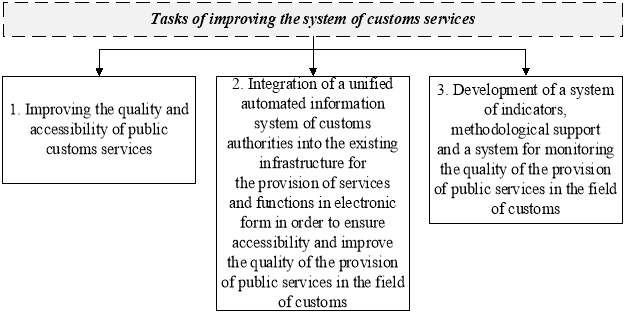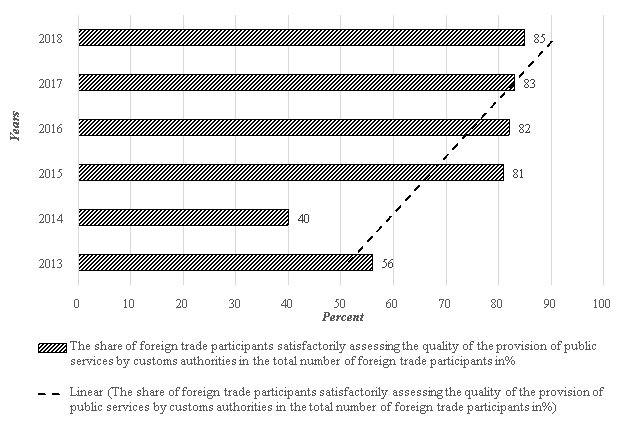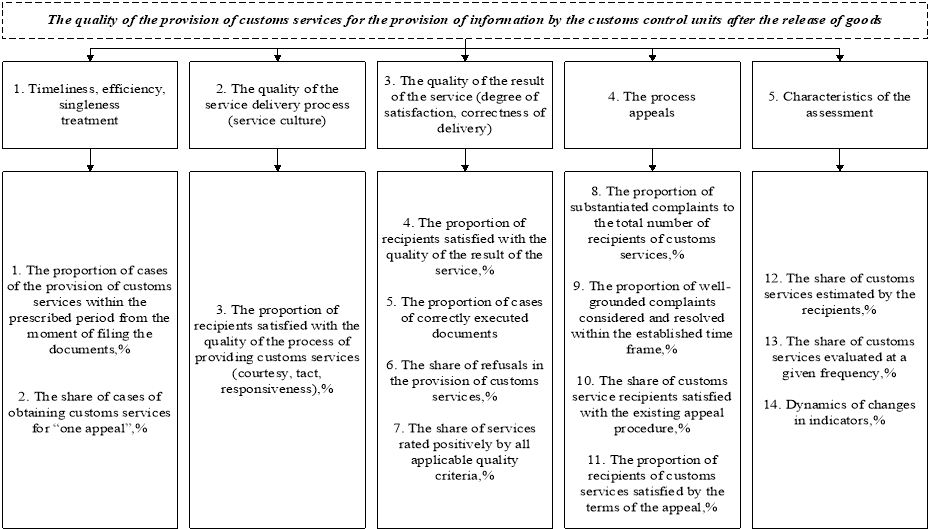The article considers customs control after the release of goods as an instrument for the implementation of public services provided by customs authorities. A system of quality indicators for the provision of customs services has been formed to provide information on the release of goods by customs control units after the release of goods. The developed system can be used for a comprehensive assessment of the effectiveness of customs control after the release of goods, as well as in the field of improving the quality and efficiency of customs services.
Keywords: customs control, customs control after the release of goods, customs services, scorecard, quality, efficiency.
The integration of the Russian Federation into world space, as well as the formation of the Eurasian Economic Union, contributed to an increase in the flow of goods and vehicles moving across the customs border. In the context of a reduction in the time for conducting current customs control, the risks of importing goods in violation of customs legislation increased [1, p. 44]. In order to prevent and identify administrative offenses and criminal offenses, customs units carry out customs control after the release of goods.
The development of the sphere of customs services involves the use and improvement of modern information technologies, as well as the introduction of new types of customs services, which are necessary for the development of foreign trade and reduce the costs of foreign trade participants. The work is devoted to the development of a classification of types of customs services and their systematization: Yu.E. Gupanova [2], M. V. Boykova [3], I. V. Ignatova [4], O. V. Grechkina S. A. Agamagomedova [5], as well as the work of other researchers.
In accordance with the Customs Service Development Strategy [6], the customs authorities plan to introduce new types of regulated customs services, including the provision of information on the release of goods. Customs control units after the release of goods provide individuals with information on the legality of the release of goods. However, at present, administrative regulations have not been developed that governed the necessary sequence of administrative procedures, and the performance and quality indicators for the provision of this service have not been determined. The development of a system of indicators is one of three tasks (Figure 1) of improving the system of providing customs services.

Fig. 1. Tasks for improving the system of customs services
To assess the quality of the provided customs services, the FCS of Russia applies the indicator that was provided for in the Strategy for the development of the customs service — “the share of foreign trade participants who satisfactorily assess the quality...” Figure 2 shows the dynamics of this indicator.
A retrospective analysis from 2013 to 2018 showed a twofold increase in foreign trade participants who satisfactorily assess the quality of the provision of customs services. We believe that this indicator does not reflect a change in the quality of certain types of regulated customs services, as well as not regulated.

Fig. 2. The proportion of participants in foreign economic activity who satisfactorily assess the quality of the provision of public services by customs authorities in 2013–2018 years, %
To assess the provision of customs services for the provision of information on the release of goods, we suggest using the following system of indicator criteria, which is presented in Figure 3.
It is assumed that the assessment of the quality of the provision of customs services for the provision of information by the customs control units after the release of goods is carried out according to the following indicators:
1) the proportion of cases of the provision of customs services by customs control units after the release of goods within the prescribed period from the moment of filing the documents. The calculation of this indicator is carried out as follows (in %): ![]() ×100, (1)
×100, (1)

Fig. 3. The system of criteria and indicators for assessing the quality of the provision of customs services for the provision of information by the customs control units after the release of goods, developed by the author
where, ![]() — the number of cases of the provision of customs services by the customs control units after the release of goods within the prescribed period from the moment of filing the documents;
— the number of cases of the provision of customs services by the customs control units after the release of goods within the prescribed period from the moment of filing the documents;
![]() — the number of customs services rendered by customs control units after the release of goods;
— the number of customs services rendered by customs control units after the release of goods;
2) the proportion of cases of receiving customs services for “one appeal”. The calculation of this indicator is carried out as follows (in %):
where, ![]() — the number of cases of obtaining customs services for “one appeal”;
— the number of cases of obtaining customs services for “one appeal”;
![]() — the number of customs services rendered by customs control units after the release of goods;
— the number of customs services rendered by customs control units after the release of goods;
3) the proportion of recipients satisfied with the quality of the process of providing customs services. The calculation of this indicator is carried out as follows (in %):
![]() ×100, (4)
×100, (4)
where, ![]() — the number of recipients satisfied with the quality of the process of providing customs services;
— the number of recipients satisfied with the quality of the process of providing customs services;
![]() — the number of recipients of customs services for the provision of information;
— the number of recipients of customs services for the provision of information;
4) percentage of recipients satisfied with the quality of the result of the service. The calculation of this indicator is carried out as follows (in %):
![]() ×100, (5)
×100, (5)
where, ![]() — the number of recipients satisfied with the quality of the result of the service;
— the number of recipients satisfied with the quality of the result of the service;
![]() — the number of recipients of customs services for the provision of information;
— the number of recipients of customs services for the provision of information;
5) the number of customs services provided to provide information on the release of goods by customs control units after the release of goods, its absolute change, average value, growth index, average growth index, change and rate of change of the growth index are determined by the following formulas:
![]() =
=![]() , (6)
, (6)
![]() =
=![]() , (7)
, (7)
![]() =
=![]() , (8)
, (8)
![]() =
=![]() , (9)
, (9)
![]() =
=![]() , (10)
, (10)
![]() =
=![]() , (11)
, (11)
where, ![]() — absolute change (increase) in the number of customs services provided by customs control units after the release of goods to interested parties units;
— absolute change (increase) in the number of customs services provided by customs control units after the release of goods to interested parties units;
![]() — change in the growth index of the number of customs services provided by customs control units after the release of goods to interested parties;
— change in the growth index of the number of customs services provided by customs control units after the release of goods to interested parties;
![]() — index of growth in the number of customs services provided by customs control units after the release of goods to interested parties;
— index of growth in the number of customs services provided by customs control units after the release of goods to interested parties;
![]() — the average growth index of the number of customs services provided by customs control units after the release of goods to interested parties during a temporary period;
— the average growth index of the number of customs services provided by customs control units after the release of goods to interested parties during a temporary period;
![]() — the rate of change in the growth index of the number of customs services provided by customs control units after the release of goods to interested parties during a temporary period;
— the rate of change in the growth index of the number of customs services provided by customs control units after the release of goods to interested parties during a temporary period;
![]() — the number of customs services provided by the customs control units after the release of goods to interested parties in the base period, units;
— the number of customs services provided by the customs control units after the release of goods to interested parties in the base period, units;
![]() ,
,![]() — the number of customs services provided by customs control units after the release of goods to interested parties in the analyzed and final periods, units;
— the number of customs services provided by customs control units after the release of goods to interested parties in the analyzed and final periods, units;
![]() – basic index of growth in the number of customs services provided by customs control units after the release of goods to interested parties;
– basic index of growth in the number of customs services provided by customs control units after the release of goods to interested parties;
![]() ,
, ![]() — initial and final growth indices of the number of customs services provided by customs control units after the release of goods to interested parties;
— initial and final growth indices of the number of customs services provided by customs control units after the release of goods to interested parties;
n — the number of time levels, year.
Thus, the totality of the proposed indicators can be used in the development of a comprehensive methodology for integrated assessment of the effectiveness of customs control after the release of goods, as well as in the field of improving the quality and efficiency of public services provided by customs authorities.
References:
- Customs control after the release of goods as a tool to ensure economic security: monograph / G. I. Nemirova, S. V. Novikov. Moscow: Rusyns, 2019.180 p.
- Gupanova Y. E. Customs Services Quality Management Methodology: Monograph. M.: RIO of the Russian Customs Academy, 2017.152 p.
- Boykova M. V. Foreign experience of customs administration: monograph / M. V. Boykova; under the general. ed. V. V. Makruseva. M.: RIO of the Russian Customs Academy, 2017.130 p.
- Ignatova I. V. The concept of customs service: the essence, structure, features. Journal of Economic Theory. 2009. No. 1. P. 117–125.
- Grechkina O. V., Agamagomedova S. A. State customs services: concept, basic characteristics, types. News of higher educational institutions. Volga region. Social Sciences. 2017. No. 3–39. P. 17–30.
- Decree of the Government of the Russian Federation of December 28, 2012 No. 2575-r (as amended on February 10, 2018) «On the Strategy for the Development of the Customs Service of the Russian Federation until 2020».







